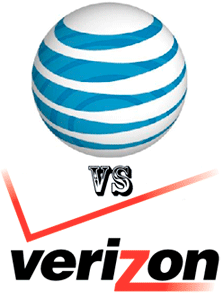
and the winnah is
My earlier AT&T versus Verizon post was labeled «part one» for a reason: it was written before I had any basis for comparison. Now, three weeks and two days into my contract with Verizon, I’ve yet to experience a dropped call. There are places with strong signals and places with weak signals; that’s no different on Verizon than AT&T. But the most important difference is that I can hold entire conversations without being disconnected a half-dozen times in succession. On AT&T I was lucky to get ten minutes of uninterrupted talk time.
The one kind of service I got from AT&T was lip service about correcting their problems. I lost count of the AT&T representatives I talked to about the problems I had with their cellular service. They all told me that measures would be put in place to fix the issue. Nothing ever changed.
AT&T has an iPhone app just for reporting service problems, and I used it frequently as well. However, the iPhone app didn’t inspire confidence: every time I submitted a problem report, the app told me I would receive a text message confirming the report. Out of the dozens of times I saw the dialog box promising my confirmation by text message I never received even one.
I do have a few complaints with Verizon. It is true that on Verizon’s network it is not possible to have an active data connection while talking on the phone. I can hardly count that in AT&T’s favor considering that on their network it was not possible to talk on the phone with or without a data connection.
Verizon has also been slow to issue the 1.4.5 update for WebOS, the platform my phone runs on. It was released weeks ago and Sprint users have had the update performed automatically since the beginning of the month. Verizon also removed Yahoo instant messaging support from the WebOS Messaging application without any good reason; Sprint customers have Yahoo in their Messaging apps. Verizon users can use only AIM or Google Talk.
These are annoyances, but they seem like minor quibbles in the face of the fact: Verizon’s network supports phone calls. AT&T’s does not.
Also in Verizon’s favor: although I’m paying Verizon a bit more than I was paying AT&T, I’m getting a lot more value. My account includes device tethering for free up to 5 gigabytes per month, which has allowed me to use my laptop on the Internet over my cellphone. AT&T’s 2Gb tethering plan costs an additional $25 every month.
I still have reservations about sending money to a CDMA cellular providerI don’t think the United States needs to have a cellular protocol that doesn’t work in the rest of the worldbut I have greater reservations about continuing to send money to a company that provided me with faulty service.
It’s really too bad. As noted earlier, I had stellar service with AT&T for years before things started going downhill. I’m sad that their decline was so dramatic that I had to leave. They shot themselves in the foot; customer loyalty comes only with vendor loyalty.
